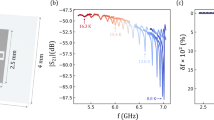Abstract
We show that magnetic flux lattice interactions are important at fields above a few thousand gauss. These interactions interfere with thermally activated current-induced flux bundle hopping and reduce the superconductor’s flux creep resistance below that estimated from the standard flux creep models (which assume completely independent hopping). We find that the flux bundles can hop independently at the low fields at which, e.g., antennas and SQUID detection coils would be used, but interact very strongly at fields typical of magnet applications.
Similar content being viewed by others
References
A.M. Campbell and J.E. Evetts, Adv. Phys. 21, 199 (1972).
M. R. Beasley, R. Labusch, and W.W. Webb, Phys. Rev. 181, 682 (1969).
K. A. Müller, M. Takashige, and J. G. Bednorz, Phys. Rev. Lett. 58, 1143 (1987).
C. Rossel, Y. Maeno, and I. Morgenstern, Phys. Rev. Lett. 62, 681 (1989).
Y. Yeshurun and A. P. Malozemoff, Phys. Rev. Lett. 60, 2202 (1988).
M. Tinkham, Introduction to Superconductivity (McGraw-Hill, New York, 1975), p. 141.
M. Tinkham, Introduction to Superconductivity (McGraw-Hill, New York, 1975), p. 149.
T.T. M. Palstra, B. Batlogg, L. F. Schneemeyer, and J.V. Waszczak, Phys. Rev. Lett. 61, 1662 (1989); R. Griessen, C.F.J. Flipse, C.W. Hagen, J. Lensink, B. Dam, and G. M. Stollman, J. Less-Common Metals 151, 39 (1989).
M. Tinkham, Introduction to Superconductivity (McGraw-Hill, New York, 1975), p. 151.
I. S. Gradshteyn and I. M. Ryzhik, Table of Integrals and Products, 4th ed. (Academic Press, New York, 1965), p. 26.
Handbook of Mathematical Functions, edited by M. Abramowitz and I.A. Stegun (Dover Pub. Inc., New York, 1964), p. 379, Eq. 9.8.5.
A large range of values have been measured, from 20 meV on up. See, for example, Y. Yeshurun, A. P. Malozemoff, and F. Holtzberg, 4th Joint MMM-Int. Conf. Vancouver, July 12–15, 1988 (U = 20 meV); R. Griessen, C. F. J. Flipse, C.W. Hagen, J. Lensink, B. Dam, and G. M. Stollman, “Critical currents and magnetic relaxation of epitaxial YBa2Cu3O7–δ films,” Proc. E-MRS Fall meeting, Strasbourg (France) and J. Less-Common Metals (1989) (U = 25 meV); C.W. Hagen and R. Griessen, a review article in Studies of High Temperature Superconductors, edited by A.V. Narlikar (Nova Science Publishers, Commack, New York, 1989), Vol. 3, pp. 159–195 (U = distribution peaked near 50 meV); T.T. M. Palstra, Critical Current Conference, SnowMass (CO) 1988; and T.T. M. Palstra, B. Batlogg, L. F. Schneemeyer, and J.V. Waszczak, Phys. Rev. Lett. 61, 1662 (1988) (U 400 meV).
G. J. Dolan, G.V. Chandrashekhar, T. R. Dinger, C. Feild, and F. Holtzberg, Phys. Rev. Lett. 62, 827 (1989).
Author information
Authors and Affiliations
Rights and permissions
About this article
Cite this article
Stephens, R.B. Flux bundle interactions. Journal of Materials Research 5, 2802–2806 (1990). https://doi.org/10.1557/JMR.1990.2802
Received:
Accepted:
Published:
Issue Date:
DOI: https://doi.org/10.1557/JMR.1990.2802




